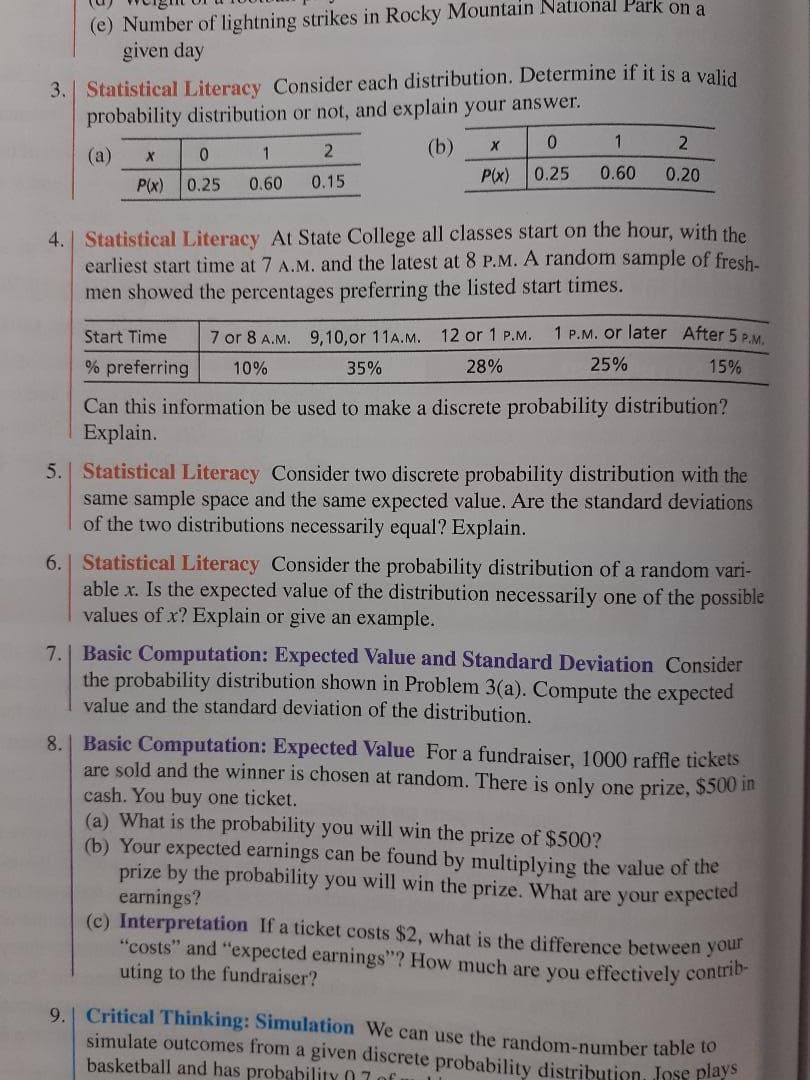(e) Number of lightning strikes in Rocky Mountain National Park on a given day Statistical Literacy Consider each distribution. Determine if it is a valid probability distribution or not, and explain your answer. 3. 1 0 2 (b) X 2 (a) 1 0 X 0.25 0.60 Pix) 0.20 0.15 0.60 P(x) 0.25 4. Statistical Literacy At State College all classes start on the hour, with the earliest start time at 7 A.M. and the latest at 8 P.M. A random sample of fresh men showed the percentages preferring the listed start times. 1 P.M. or later After 5 PM 12 or 1 P.M. Start Time 9,10,or 11A.M. 7 or 8 A.M. 25% % preferring 28% 15% 10% 35% Can this information be used to make a discrete probability distribution? Explain. Statistical Literacy Consider two discrete probability distribution with the same sample space and the same expected value. Are the standard deviations of the two distributions necessarily equal? Explain. 5. Statistical Literacy Consider the probability distribution of a random vari- able x. Is the expected value of the distribution necessarily one of the possible values of x? Explain or give an example. 6. 7.| Basic Computation: Expected Value and Standard Deviation Consider the probability distribution shown in Problem 3(a). Compute the expected value and the standard deviation of the distribution. 8. Basic Computation: Expected Value For a fundraiser, 1000 raffle tickets are sold and the winner is chosen at random. There is only one prize, $500 in cash.You buy one ticket. (a) What is the probability you will win the prize of $500? (b) Your expected earnings can be found by multiplying the value of the prize by the probability you will win the prize. What are your expected earnings? (c) Interpretation If a ticket costs $2, what is the difference between your "costs" and "expected earnings"? How much are you effectively contrib- uting to the fundraiser? 9,1 Critical Thinking: Simulation We can use the random-number table to simulate outcomes from a given discrete probability distribution. Jose play basketball and has probability 0.7 of
Contingency Table
A contingency table can be defined as the visual representation of the relationship between two or more categorical variables that can be evaluated and registered. It is a categorical version of the scatterplot, which is used to investigate the linear relationship between two variables. A contingency table is indeed a type of frequency distribution table that displays two variables at the same time.
Binomial Distribution
Binomial is an algebraic expression of the sum or the difference of two terms. Before knowing about binomial distribution, we must know about the binomial theorem.
Chapter 5 The Binomial Probability Distribution and Related Topics (Undderstanding Statistics, 12th Ed)
Question # 7
Please help show steps how to do problem # 7 on the attached jpeg. Thank you!

Trending now
This is a popular solution!
Step by step
Solved in 3 steps with 3 images




